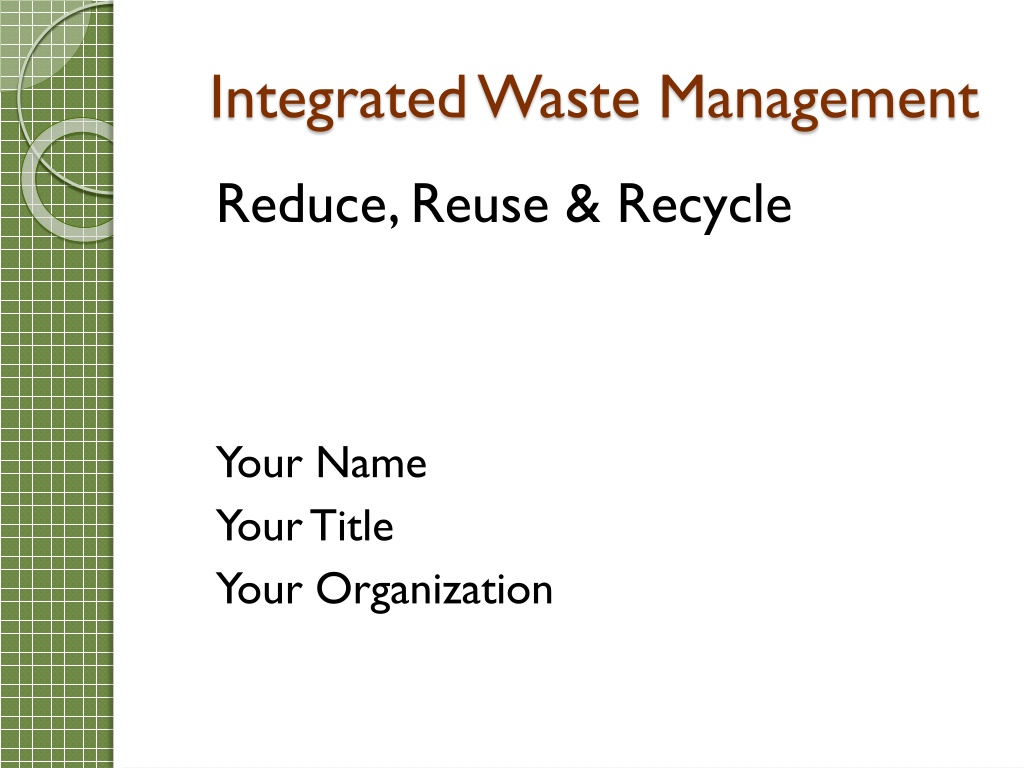Effective Strategies for Integrated Waste Management
Learn about the importance of integrated waste management, including waste reduction, reuse, and recycling practices. Discover how managing waste can conserve resources, reduce pollution, and save landfill space. Explore strategies such as source reduction, reuse of products, and making environmentally conscious choices to minimize waste generation.
Download Presentation

Please find below an Image/Link to download the presentation.
The content on the website is provided AS IS for your information and personal use only. It may not be sold, licensed, or shared on other websites without obtaining consent from the author. Download presentation by click this link. If you encounter any issues during the download, it is possible that the publisher has removed the file from their server.
E N D
Presentation Transcript
Integrated Waste Management Reduce, Reuse & Recycle Your Name Your Title Your Organization
Image: Fairfax County Solid Waste Management Integrated Solid Waste Management: A set of plans to manage solid waste Adopted by many governments A means of achieving sustainability
Why Manage Waste? Conserves resources & energy Reduces water & air pollution Saves landfill space Waste = Food In nature there is no waste Cradle to cradle design Product components are recyclable or biodegradable Extended Producer Responsibility (EPR) or Product Stewardship http://t3.gstatic.com/images?q=tbn:37BjLInRl-6joM:http://www.cawrecycles.org/files/images/GHG.jpg
Total US MSW Generation 2008 (by material) EPA
Source Reduction Image: Fairfax County Solid Waste Management
Source Reduction or Reduce Preferred method: Prevents the generation of waste in the first place Manufacturer: Decrease materials/energy used during manufacturing/distribution Consumer: Purchase items with minimal packaging, avoid disposable products Includes backyard composting http://t3.gstatic.com/images?q=tbn:YWG_ESLwA6P-IM:http://www.ways2gogreen.com/images/usebothsides.jpg
Reuse Image: Fairfax County Solid Waste Management
http://t0.gstatic.com/images?q=tbn:AHxMAgPwHdVTWM:http://www.earthwisebags.com/earthwisebags/images/halloween_resusableBagsL2.jpghttp://t0.gstatic.com/images?q=tbn:AHxMAgPwHdVTWM:http://www.earthwisebags.com/earthwisebags/images/halloween_resusableBagsL2.jpg Reuse Prolonging a product s usable life Repairing items, selling them or donating them to charity Using durable rather than disposable items (i.e. reusable shopping bags, metal spoons) Preferable to recycling because item does not need to be collected/reprocessed
Metal vs. Plastic Spoon Cost to Purchase: 50 cents for metal vs. one cent for plastic Cost to Produce & Maintain: Resources (metal, petroleum, water, chemicals, etc.) Energy used (in extraction, manufacturing, transportation) External Costs: Pollution (during extraction, manufacturing, transportation) Disposal (landfill, incineration, litter clean-up) Savings from repetitive use of metal spoon: Priceless!
Recycle Image: Fairfax County Solid Waste Management
http://t1.gstatic.com/images?q=tbn:jOuNvCTG-ybftM:http://www.clipartguide.com/_small/0808-0711-0714-5559.jpghttp://t1.gstatic.com/images?q=tbn:jOuNvCTG-ybftM:http://www.clipartguide.com/_small/0808-0711-0714-5559.jpg Recycle Taking a product at the end of its useful life and using all or part of it to make another product Benefits: Saves energy, natural resources, and landfill space, reduces pollution, creates jobs and useful products Requires collection, processing, remanufac- turing and purchase (Close the Loop!) EPA estimates 75% of our waste is recyclable
Waste Disposal Last in the Hierarchy Image: Fairfax County Solid Waste Management
Waste Disposal Resource Recovery Resource Recovery (AKA Waste-to-Energy): Waste is burned to produce energy Preferred to landfilling reduces bulk of municipal waste to ash and provides energy Downsides: Some items may be difficult to burn or cause potentially harmful emissions Strict regulatory restrictions and high environmental and economic costs http://t0.gstatic.com/images?q=tbn:4ATMVqC-YwTu6M:http://sei.aspweb.cz/images/content/Waste-to-energy.jpg
Waste Disposal Incineration & Landfilling Strict regulatory restrictions and high environmental and economic costs Items barely decompose in a modern landfill Landfills face capacity restrictions NIMBY syndrome
Image: Fairfax County Solid Waste Management Resource depletion, pollution and landfills are not the legacy we want to leave to future generations Recycling/reuse saves precious resources & energy Best solution is to reduce waste in the first place
Resources Oklahoma Recycling Association (OKRA) www.recycleok.org Regional Waste Exchange for Business www.zerowastenetwork.org/RENEWDEV Local Waste Exchange for Individuals www.freecycle.org Additional Resources:
Contact Information Your Name Your Organization Your title Your address Your phone Your fax Your email Your web address























